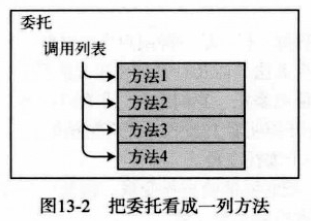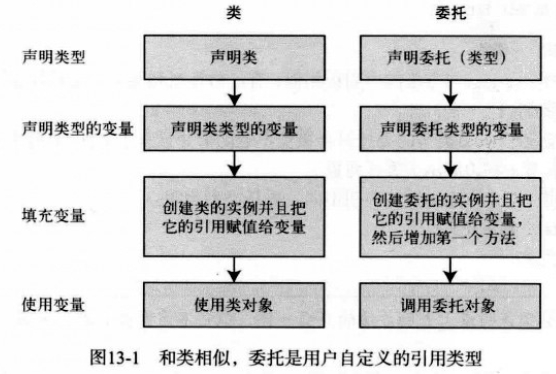一、委托初窥:一个拥有方法的对象
(1)本质:持有一个或多个方法的对象;委托和典型的对象不同,执行委托实际上是执行它所“持有”的方法。

(2)如何使用委托?
①声明委托类型(delegate关键字)
②使用该委托类型声明一个委托变量
③为委托类型增加方法
④调用委托执行方法

(3)委托的恒定性:
组合委托、为委托+=增加方法以及为委托-=移除方法让我们看起来像是委托被修改了,其实它们并没有被修改。事实上,委托是恒定的。
在为委托增加和移除方法时实际发生的是创建了一个新的委托,其调用列表是增加和移除后的方法结果。

delegate void PrintFunction();
class Test
{
public void Print1()//实例方法
{
Console.WriteLine( "Print1 -- instance" );
}
public static void Print2()//静态方法
{
Console.WriteLine( "Print2 -- static" );
}
}
class Program
{
static void Main()
{
Test t = new Test();
PrintFunction pf;
pf = t.Print1;
pf += Test.Print2;
pf += t.Print1;
pf += Test.Print2;
if ( pf != null )
{
pf();
}
else
{
Console.WriteLine( "Delegate is empty" );
}
}
}
补充:链式委托写法1
// 申明委托并绑定第一个方法
TestMulticastDelegate tmd = new TestMulticastDelegate(PrintMessage1);
// 绑定第二个方法
tmd += new TestMulticastDelegate(PrintMessage2);
// 绑定第三个方法
tmd += new TestMulticastDelegate(PrintMessage3);
// 调用委托
tmd();
链式委托写法2
如上的例子
链式委托写法3
TestMulticastDelegate tmd1 = new TestMulticastDelegate(PrintMessage1);
TestMulticastDelegate tmd2 = new TestMulticastDelegate(PrintMessage2);
TestMulticastDelegate tmd3 = new TestMulticastDelegate(PrintMessage3);
// 核心本质:将三个委托串联起来
TestMulticastDelegate tmd = tmd1 + tmd2 + tmd3;
tmd.Invoke();
在实际开发中经常使用第二种方法,但是却不能不了解方法三,它是链式委托的本质所在。
//http://www.cnblogs.com/edisonchou/p/4827578.html 链式委托的讲解
二、匿名方法
在委托所持有的方法中,如果某个方法只被使用一次,这种情况下,除了创建委托语法的需要,没有必要创建独立的具名方法。匿名方法应运而生。
匿名方法是在初始化委托时内联(inline)声明的方法。
using System;
class Program
{
delegate int OtherDel(int InParam);
static void Main()
{
OtherDel del = delegate(int x)
{
return x + 20;
};
Console.WriteLine("{0}", del(5));
Console.WriteLine("{0}", del(6));
}
}
三、Lambda表达式:匿名方法的另一种形式,更易阅读
(1)本质:简化语法的”语法糖“;
(2)要点:
①Lambda表达式中的参数列表(参数数量、类型和位置)必须与委托相匹配;
②表达式中的参数列表不一定需要包含类型,除非委托有ref或out关键字(此时必须显示声明);
③如果没有参数,必须使用一组空的圆括号;
(3)语法:

所有Lambda表达式都使用Lambda运算符=>,该运算符读作"goes to"。Lambda运算符的左边是输入参数(如果有),右边是表达式或语句块。
参考文章:
http://www.cnblogs.com/edisonchou/p/3704510.html
http://www.cnblogs.com/kingmoon/archive/2011/05/03/2035696.html